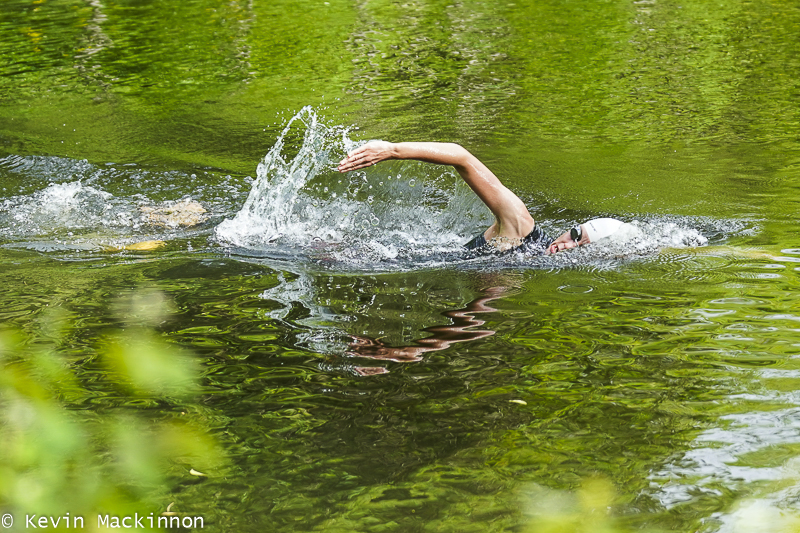It’s time to swim – open water 101
Open water swim tips and a workout to get the most out of your swim training this summer
 Photo by:
Kevin Mackinnon
Photo by:
Kevin Mackinnon
While many people complain about the “black line fever” associated with pool swimming, the “no bottom fever” from open water is worse. For others, the thought of that initial cold slap to the face that sucks the breath out of your lungs and sends a jolt to your heart keeps them away from the shores until the summer sun has had enough time to bring up the water temperatures – which for pretty much the entire country, is now.
Surveys continuously point out that one of the biggest barriers to participation in triathlon is the swim. Many people find swimming amongst a crowd of people particularly challenging. With the COVID-19 pandemic ensuring that we don’t have big crowds to worry about in the water, now is a great time to get yourself more comfortable with open water swimming.
Cold water hacks
Most Canadian lakes will have warmed up by now, but for those who are still dealing with cold water, there there are a number of things you can do. A thermos of warm water poured down the wetsuit just prior to getting in can help the initial transition, or you can just drink lots of warm tea before hand and create your own warm water (pee in your wetsuit) upon entering the water. There are also neoprene booties, gloves and caps available. You can also double up silicone caps and apply Vaseline on the cheeks, hands or feet. While it’s messy, it helps. One of my favourite tips to share is the use of ear plugs. A simple pair of ear plugs can make cold water considerably more comfortable. The colder the water, the more likely one is to experience vertigo. Ear plugs can erase that effect completely. The foam ones used for noise reduction work great, but silicone is best.
Another strategy is to have a “training” wetsuit and a “racing” suit. Racing suits use thinner neoprene wherever it’s needed for flexibility and heavier where it’s not. Generally a single thickness suit is cheaper, more durable and warmer, but it’s slower. I like this solution as it falls into the “train heavy – race light.” philosophy I believe in.
Buddy up
Swimming alone in open water is never a great idea, but for some it’s positively terrifying. If you’re someone who has anxiety over the “vastness” of open water, find others to get in with. If that’s not available to you then maybe a friend can paddle beside you in a kayak. For most swimmers tackling this fear head-on will result in its reduction after only a few sessions.
Crowd control
Hopefully either later this year (or possibly we’ll be waiting until next year), you’ll have a chance to try and get more comfortable with having others in close proximity during your swims. For those who are challenged by the idea of getting in with too many others, the thrashing at the start of a typical triathlon is scary. In a way, the solution is the same as being anxious about getting in alone. Get in with others and get used to having them close to you. It doesn’t take long to realize that the contact that comes in the heat of competition and training is never as bad as your imagination.
Open water training
And what to do, once you’re in? Many athletes simply get in and swim long straight swims where the level of effort is profoundly lower than a race effort, or the cumulative effect of a pool session. For that reason, have a planned workout ready. It’s ideal to have others with you. An effective lake effort might look like this:
- 10 minutes of warm up.
- 4 x 40 seconds at start speed/ rest 30 seconds between each effort
- 400 m (or 6 to 7 minutes) moderate/45 seconds rest
- 4 x 200 m (or 3 to 4 minutes) strong/45 seconds rest
- 800 m (or around 15 minutes) of steady draft work. Exchange the lead every 50 strokes – the leader pulls over and the others swim past. This is best done in groups of three to four.
- 4 x 40 seconds surge/30 seconds easy between each effort
- 400 meters (7 to 8 minutes) cool down
Open water swimming is an essential part of a triathlete’s training regimen. Some have it easier than others as far as accessibility and conditions, but with a few tricks and some determination almost every Canadian should be able to take advantage of our beautiful lakes and oceans.
Clint Lien is the head coach of Mercury Rising Triathlon in Victoria www.mercuryrisingtriathlon.com
This story originally appeared in the July, 2018 issue of Triathlon Magazine Canada.
